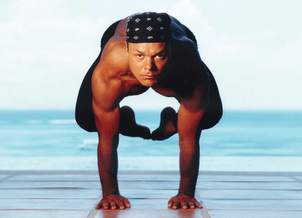For those of you who haven't met Marc yet, he is a new instructor at Bikram Yoga SLC! He's come a long way since a severe motorcycle accident, including getting 1st place in the men's division in this year's Regional Yoga Asana Championships. The following is his motivating story.
Adversity
comes to all. It is part of life. But, hearing about adversity is,
for the most part, neither very interesting nor instructive. However, a
story about adversity overcome is exciting and most instructive. Marc
Linton's is such a story.
In a severe motorcycle accident in August of 2002,
Marc suffered multiple injuries that included compression fractured
vertebrae, extensive soft tissue damage, a fractured skull, and serious
neurological damage. "Before the accident I was already dealing with
anxiety and depression issues. "The brain injury compounded the
anxiety and depression and caused memory issues, agoraphobia, and socialization
problems. "I felt absolutely overwhelmed by it all. "I
was collecting Social Security disability, was on six different medications and
was at the end of my rope. I wasn't healing, I was just more and more
medicated, and the bills were piling up.
"In desperation I decided I needed to try something different and
one doctor had told me that yoga gave him relief from his back pain.
"My first practice at Bikram Yoga I was completely overwhelmed,
nauseated, dizzy and spent most of the class laying on the floor. "However, after class was over I
experienced a window where I was pain free for the first time in over four
years. "With each practice that
pain-free window opened more and more.
"I found myself practicing six days a week, sometimes twice a day
to alleviate the pain. "Initially I
came to yoga for my back pain, but I found it helping all of the issues I was
dealing with including the brain injury.
"My memory improved, the depression was lifting and about six
months into practice I was out of pain and shedding the many medications.
"That's when I decided decided I needed to teach this yoga. "I remember
thinking: How do people not know this?"
Almost exactly two years after Marc began his practice, and as he
continued to heal, Bikram granted him a full scholarship to attend teacher
training. Marc's successful completion of this very strenuous (physically,
mentally, and emotionally) training course in the fall of 2008 overcoming-
against all odds the limitations, and memory issues of the brain injury was
proof of his healing. Upon returning from training, Marc began teaching
at the Bikram Yoga Sandy studio, subsequently managed and taught at the Bikram
Yoga Ogden studio for the summer, and then in the fall returned full-time to
Sandy. He now also teaches at Bikram Yoga S.L.C. since April 2012 and
offers personal Health/Wellness & Anxiety/Depression coaching. "If
someone had told me 10 years ago that I was going to be teaching yoga and
coaching others, I would have laughed. . . but here I am. "I teach yoga
because it works. " I teach it because it helped give me my life
back."
Marc enjoys Boarding (snow, wake, and surf), Cycling (road and mountain),
rock climbing, hiking, backpacking, mixing underground dance music, and
generally having a good time. He says, "Don't be afraid of dying.
"Be afraid of not living!"

































 My dad started private yoga
sessions with me last fall. He was having some lower back and hip
issues that I was confident yoga could help—they did and he’s now
officially a yoga junkie.
My dad started private yoga
sessions with me last fall. He was having some lower back and hip
issues that I was confident yoga could help—they did and he’s now
officially a yoga junkie.


